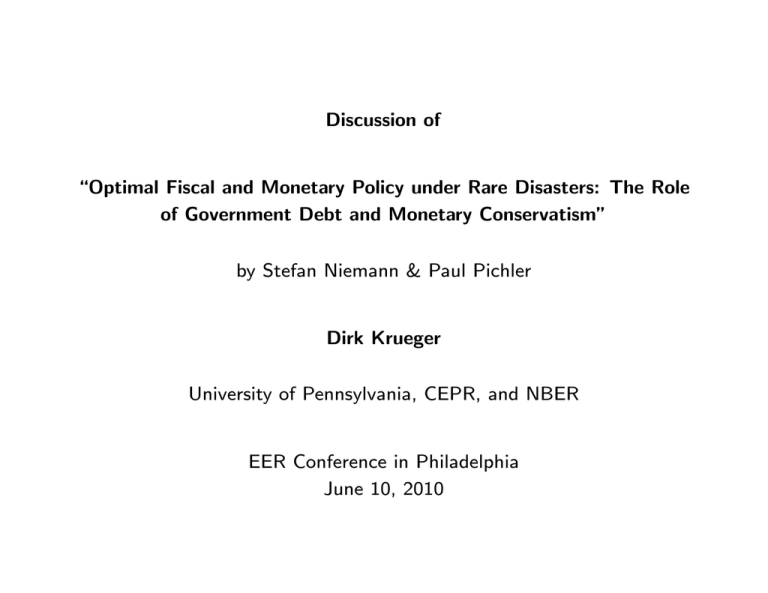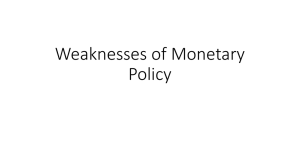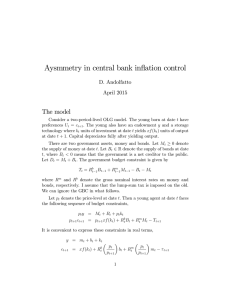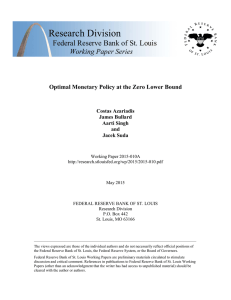Discussion of of Government Debt and Monetary Conservatism"
advertisement

Discussion of
\Optimal Fiscal and Monetary Policy under Rare Disasters: The Role
of Government Debt and Monetary Conservatism"
by Stefan Niemann & Paul Pichler
Dirk Krueger
University of Pennsylvania, CEPR, and NBER
EER Conference in Philadelphia
June 10, 2010
Motivation
Great Recession of 2008-20??: Massive decline in economic activity.
Massive (discretionary?) response of monetary and scal policy
{ Monetary policy: reduction in i (and more exotic measures)
{ Fiscal policy: expansion in G and in B
[Add GDP Growth Plot]
Federal Funds Effective Rate
20
18
16
Fed Funds Rate
14
12
10
8
6
4
2
0
1985
1990
1995
2000
Year
2005
2010
This Paper
Determines numerically the optimal scal (tax and debt) and monetary
(interest rate and money supply) policy in DSGE model with
{ Monopolistic competition
{ Price rigidity
{ Transaction costs that induce a money demand function
This Paper
Three Key model ingredients not present in classic Ramsey optimal
policy literature (as in e.g. Schmitt-Grohe and Uribe, 2004).
{ Rare productivity and government spending \disasters"
{ Potentially non-benevolent objective of the government
{ Inability of government to commit to policies ) time consistency
problem
Model: Standard Elements (Households)
Households are workers, consumers-savers and producers
Preferences
E0
1
X
t=0
c1t
t
1
As worker, earn after tax wage (1
ht
!
t)Ptwtht:
Model: Standard Elements (Households)
As consumer purchases nal good, which is a CES aggregate of continuum of intermediate goods with elasticity of substitution : Cost of
purchasing ct is
"
ctPt
1+s
Mt
!#
Ptct
which delivers money demand equation. Here s is a time and policyinvariant function.
As saver purchases cash Mt+1 and nominal government bonds Bt+1
1
at price qt = 1+i
t
Model: Standard Elements (Households)
As monopolistically competitive producer of intermediate good with
linear technology and aggregate productivity at faces demand
P~t
~
d(Pt; Pt; yt) = yt
Pt
Price adjustment costs
2
P~t
P~t 1
1
!2
!
Model: Standard Elements (Government)
1
Monetary policy Mt+1; qt = 1+i
t
Fiscal policy t; Bt+1
Budget constraint
tPtwtht
+ (Mt+1
Mt) + qtBt+1 = Ptgt + Bt
Model: Nonstandard Elements
Rare disasters
log at+1 =
a log at
log gt+1 = (1
+ "at+1 + log(1
t)
g
g )g + g log gt + "t+1 + log(1 + t)
Government objective: period return function
ct1
1
Pt
Pt 1
ht
and intertemporal discount factor
:
!2
Model: Nonstandard Elements: Optimal Markov
Policy without Commitment
Government cannot commit to future policies (but can commit to not
default outright on its debt).
Individual state variables S = (M; B; P~ ): Aggregate state variables
S = (M ; B; P 1; a; g ):
Government policy
Given
maps S into (M 0; B 0; ; q ):
; household decision rule D maps (S; S ) into (M 0; B 0; P~ ; c; h; ):
Comments: The Questions and the Model
Ambitious model delivers convincing answers, but for what question?
I take main questions to be (authors may disagree)
{ How should monetary and scal policy respond to a disaster?
{ Without government commitment, should there be monetary conservatism?
Question 1: How should Policy respond to a Disaster?
Our main interest in studying stabilization policies under lack of
commitment is in characterizing the optimal response to a simultaneous disaster in a and g. Although our model is tacit about
its genesis, such event can be casually interpreted as a nancial
crisis [p. 24]
How about the current nancial crisis?
Question 1: How should Policy respond to a Disaster?
Collapse of 30% in TFP?
(Exogenous) increase in G by 50% a disaster? Certainly in the model!
Welfare calculations!?
Why do we need a model with
out we don't.
> 0 to answer this question? Turns
[Add p. 26-27 Plot]
Question 2: Why Monetary Conservatism
Government has weird preferences
c1
1
h
With commitment of government, no role for
P
P 1
2
> 0:
But without commitment there might be in ation bias. Policies pursued with government objective > 0 might be welfare enhancing
even if they maximize the \wrong" objective.
Results seem to con rm this.
Question 2: Why Monetary Conservatism
With = 0; 2 model has di erent ergodic distributions. Not clear the
gure gives conclusive answers about welfare.
Would really like to see:
{ Interpret
as a structural parameter and calibrate it.
{ Let government choose
optimally, once and for all with full
commitment. What would it be?
Side remark: do we really need rare disasters to answer this question?
[Add p. 25 Plot]
Comments: Computation
Large shocks: local approximation might not be good enough. Paper
uses global techniques. Good!
{ Show how good, relative to local approximations.
{ Show how nonlinear model is
Approximation with polynomials e cient, but usually not good if policy functions have kinks. Doesn't the zero lower bound for i cause
kinks?
To Conclude
Very ambitious model, computed with methods at the frontier of what
is feasible.
Lots of answers. But question(s) could be sharpened.
Model used should t the question(s). Correct shocks? Reasonable
propagation?









